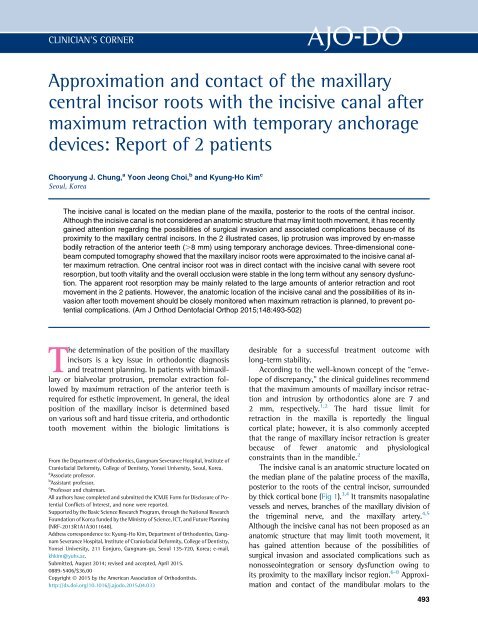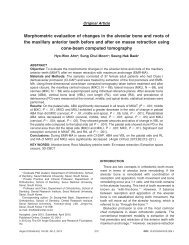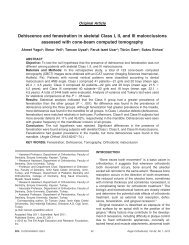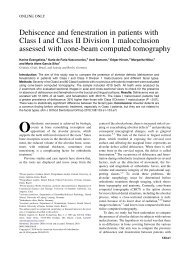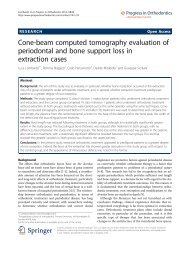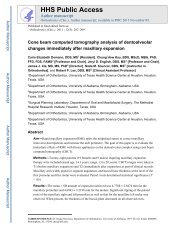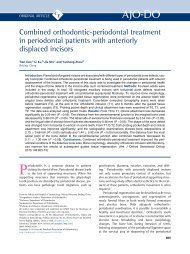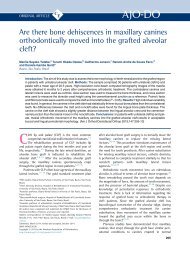Approximation and contact of the maxillary central incisor roots with the incisive canal after maximum retraction with temporary anchorage devices_ Report of 2 patients
artigos ortodontia
artigos ortodontia
You also want an ePaper? Increase the reach of your titles
YUMPU automatically turns print PDFs into web optimized ePapers that Google loves.
CLINICIAN'S CORNER<br />
<strong>Approximation</strong> <strong>and</strong> <strong>contact</strong> <strong>of</strong> <strong>the</strong> <strong>maxillary</strong><br />
<strong>central</strong> <strong>incisor</strong> <strong>roots</strong> <strong>with</strong> <strong>the</strong> <strong>incisive</strong> <strong>canal</strong> <strong>after</strong><br />
<strong>maximum</strong> <strong>retraction</strong> <strong>with</strong> <strong>temporary</strong> <strong>anchorage</strong><br />
<strong>devices</strong>: <strong>Report</strong> <strong>of</strong> 2 <strong>patients</strong><br />
Chooryung J. Chung, a Yoon Jeong Choi, b <strong>and</strong> Kyung-Ho Kim c<br />
Seoul, Korea<br />
The <strong>incisive</strong> <strong>canal</strong> is located on <strong>the</strong> median plane <strong>of</strong> <strong>the</strong> maxilla, posterior to <strong>the</strong> <strong>roots</strong> <strong>of</strong> <strong>the</strong> <strong>central</strong> <strong>incisor</strong>.<br />
Although <strong>the</strong> <strong>incisive</strong> <strong>canal</strong> is not considered an anatomic structure that may limit tooth movement, it has recently<br />
gained attention regarding <strong>the</strong> possibilities <strong>of</strong> surgical invasion <strong>and</strong> associated complications because <strong>of</strong> its<br />
proximity to <strong>the</strong> <strong>maxillary</strong> <strong>central</strong> <strong>incisor</strong>s. In <strong>the</strong> 2 illustrated cases, lip protrusion was improved by en-masse<br />
bodily <strong>retraction</strong> <strong>of</strong> <strong>the</strong> anterior teeth (.8 mm) using <strong>temporary</strong> <strong>anchorage</strong> <strong>devices</strong>. Three-dimensional conebeam<br />
computed tomography showed that <strong>the</strong> <strong>maxillary</strong> <strong>incisor</strong> <strong>roots</strong> were approximated to <strong>the</strong> <strong>incisive</strong> <strong>canal</strong> <strong>after</strong><br />
<strong>maximum</strong> <strong>retraction</strong>. One <strong>central</strong> <strong>incisor</strong> root was in direct <strong>contact</strong> <strong>with</strong> <strong>the</strong> <strong>incisive</strong> <strong>canal</strong> <strong>with</strong> severe root<br />
resorption, but tooth vitality <strong>and</strong> <strong>the</strong> overall occlusion were stable in <strong>the</strong> long term <strong>with</strong>out any sensory dysfunction.<br />
The apparent root resorption may be mainly related to <strong>the</strong> large amounts <strong>of</strong> anterior <strong>retraction</strong> <strong>and</strong> root<br />
movement in <strong>the</strong> 2 <strong>patients</strong>. However, <strong>the</strong> anatomic location <strong>of</strong> <strong>the</strong> <strong>incisive</strong> <strong>canal</strong> <strong>and</strong> <strong>the</strong> possibilities <strong>of</strong> its invasion<br />
<strong>after</strong> tooth movement should be closely monitored when <strong>maximum</strong> <strong>retraction</strong> is planned, to prevent potential<br />
complications. (Am J Orthod Dent<strong>of</strong>acial Orthop 2015;148:493-502)<br />
The determination <strong>of</strong> <strong>the</strong> position <strong>of</strong> <strong>the</strong> <strong>maxillary</strong><br />
<strong>incisor</strong>s is a key issue in orthodontic diagnosis<br />
<strong>and</strong> treatment planning. In <strong>patients</strong> <strong>with</strong> bi<strong>maxillary</strong><br />
or bialveolar protrusion, premolar extraction followed<br />
by <strong>maximum</strong> <strong>retraction</strong> <strong>of</strong> <strong>the</strong> anterior teeth is<br />
required for es<strong>the</strong>tic improvement. In general, <strong>the</strong> ideal<br />
position <strong>of</strong> <strong>the</strong> <strong>maxillary</strong> <strong>incisor</strong> is determined based<br />
on various s<strong>of</strong>t <strong>and</strong> hard tissue criteria, <strong>and</strong> orthodontic<br />
tooth movement <strong>with</strong>in <strong>the</strong> biologic limitations is<br />
From <strong>the</strong> Department <strong>of</strong> Orthodontics, Gangnam Severance Hospital, Institute <strong>of</strong><br />
Crani<strong>of</strong>acial Deformity, College <strong>of</strong> Dentistry, Yonsei University, Seoul, Korea.<br />
a Associate pr<strong>of</strong>essor.<br />
b Assistant pr<strong>of</strong>essor.<br />
c Pr<strong>of</strong>essor <strong>and</strong> chairman.<br />
All authors have completed <strong>and</strong> submitted <strong>the</strong> ICMJE Form for Disclosure <strong>of</strong> Potential<br />
Conflicts <strong>of</strong> Interest, <strong>and</strong> none were reported.<br />
Supported by <strong>the</strong> Basic Science Research Program, through <strong>the</strong> National Research<br />
Foundation <strong>of</strong> Korea funded by <strong>the</strong> Ministry <strong>of</strong> Science, ICT, <strong>and</strong> Future Planning<br />
(NRF-2013R1A1A3011648).<br />
Address correspondence to: Kyung-Ho Kim, Department <strong>of</strong> Orthodontics, Gangnam<br />
Severance Hospital, Institute <strong>of</strong> Crani<strong>of</strong>acial Deformity, College <strong>of</strong> Dentistry,<br />
Yonsei University, 211 Eonjuro, Gangnam-gu, Seoul 135-720, Korea; e-mail,<br />
khkim@yuhs.ac.<br />
Submitted, August 2014; revised <strong>and</strong> accepted, April 2015.<br />
0889-5406/$36.00<br />
Copyright Ó 2015 by <strong>the</strong> American Association <strong>of</strong> Orthodontists.<br />
http://dx.doi.org/10.1016/j.ajodo.2015.04.033<br />
desirable for a successful treatment outcome <strong>with</strong><br />
long-term stability.<br />
According to <strong>the</strong> well-known concept <strong>of</strong> <strong>the</strong> “envelope<br />
<strong>of</strong> discrepancy,” <strong>the</strong> clinical guidelines recommend<br />
that <strong>the</strong> <strong>maximum</strong> amounts <strong>of</strong> <strong>maxillary</strong> <strong>incisor</strong> <strong>retraction</strong><br />
<strong>and</strong> intrusion by orthodontics alone are 7 <strong>and</strong><br />
2 mm, respectively. 1,2 The hard tissue limit for<br />
<strong>retraction</strong> in <strong>the</strong> maxilla is reportedly <strong>the</strong> lingual<br />
cortical plate; however, it is also commonly accepted<br />
that <strong>the</strong> range <strong>of</strong> <strong>maxillary</strong> <strong>incisor</strong> <strong>retraction</strong> is greater<br />
because <strong>of</strong> fewer anatomic <strong>and</strong> physiological<br />
constraints than in <strong>the</strong> m<strong>and</strong>ible. 2<br />
The <strong>incisive</strong> <strong>canal</strong> is an anatomic structure located on<br />
<strong>the</strong> median plane <strong>of</strong> <strong>the</strong> palatine process <strong>of</strong> <strong>the</strong> maxilla,<br />
posterior to <strong>the</strong> <strong>roots</strong> <strong>of</strong> <strong>the</strong> <strong>central</strong> <strong>incisor</strong>, surrounded<br />
by thick cortical bone (Fig 1). 3,4 It transmits nasopalatine<br />
vessels <strong>and</strong> nerves, branches <strong>of</strong> <strong>the</strong> <strong>maxillary</strong> division <strong>of</strong><br />
<strong>the</strong> trigeminal nerve, <strong>and</strong> <strong>the</strong> <strong>maxillary</strong> artery. 4,5<br />
Although <strong>the</strong> <strong>incisive</strong> <strong>canal</strong> has not been proposed as an<br />
anatomic structure that may limit tooth movement, it<br />
has gained attention because <strong>of</strong> <strong>the</strong> possibilities <strong>of</strong><br />
surgical invasion <strong>and</strong> associated complications such as<br />
nonosseointegration or sensory dysfunction owing to<br />
its proximity to <strong>the</strong> <strong>maxillary</strong> <strong>incisor</strong> region. 6-8 <strong>Approximation</strong><br />
<strong>and</strong> <strong>contact</strong> <strong>of</strong> <strong>the</strong> m<strong>and</strong>ibular molars to <strong>the</strong><br />
493
494 Chung, Choi, <strong>and</strong> Kim<br />
Fig 1. CBCT images <strong>of</strong> <strong>the</strong> <strong>incisive</strong> <strong>canal</strong>. The <strong>incisive</strong> <strong>canal</strong> (arrows) is surrounded by cortical bone.<br />
The axial section represents <strong>the</strong> apical third <strong>of</strong> <strong>the</strong> <strong>incisor</strong> <strong>roots</strong>. Notice that <strong>the</strong> width <strong>of</strong> <strong>the</strong> <strong>incisive</strong> <strong>canal</strong><br />
is larger than <strong>the</strong> interroot distance between <strong>the</strong> <strong>central</strong> <strong>incisor</strong>s in <strong>the</strong> axial view.<br />
m<strong>and</strong>ibular <strong>canal</strong> <strong>and</strong> <strong>the</strong> inferior alveolar neurovascular<br />
bundle during orthodontic tooth movement have also<br />
been reported 9-11 <strong>and</strong> in rare incidences were associated<br />
<strong>with</strong> <strong>temporary</strong> pares<strong>the</strong>sia <strong>of</strong> <strong>the</strong> lower lip. 9,10<br />
The following 2 case reports illustrate <strong>the</strong> <strong>contact</strong><br />
<strong>and</strong> approximation <strong>of</strong> <strong>the</strong> <strong>maxillary</strong> <strong>central</strong> <strong>incisor</strong> <strong>roots</strong><br />
to <strong>the</strong> <strong>incisive</strong> <strong>canal</strong> <strong>after</strong> <strong>maximum</strong> <strong>retraction</strong> <strong>with</strong> <strong>temporary</strong><br />
<strong>anchorage</strong> <strong>devices</strong>.<br />
CASE REPORTS<br />
Patient 1<br />
Patient 1 was a 19-year-old woman <strong>with</strong> chief complaints<br />
<strong>of</strong> lip prominence <strong>and</strong> protrusion. The intraoral<br />
photographs <strong>and</strong> cephalograms indicated a skeletal<br />
Class II malocclusion <strong>with</strong> a protrusive pr<strong>of</strong>ile. A panoramic<br />
radiograph showed no gross abnormalities. She<br />
had no notable medical history (Fig 2).<br />
The overall goals <strong>of</strong> treatment were to improve <strong>the</strong><br />
protrusive pr<strong>of</strong>ile <strong>and</strong> to obtain a Class I occlusion <strong>with</strong><br />
ideal overjet <strong>and</strong> overbite. Four first premolars were extracted,<br />
<strong>and</strong> orthodontic treatment was initiated using<br />
0.022-in slot Roth prescription self-ligating brackets<br />
(Clippy-C; Tomy International, Tokyo, Japan). In addition,<br />
4 miniscrews (Ortholution, Gyeonggi-do, Korea),<br />
one per quadrant, were inserted between <strong>the</strong> second<br />
premolars <strong>and</strong> <strong>the</strong> first molars to reinforce <strong>anchorage</strong><br />
during space closure. We used 150-g nickel-titanium<br />
coil springs (Tomy International) <strong>and</strong> elastomeric modules<br />
for anterior <strong>retraction</strong> via en-masse sliding mechanics.<br />
Since <strong>the</strong> patient lived abroad, she was able<br />
to visit <strong>the</strong> clinic only once every 4 months on average<br />
during her vacations.<br />
The duration <strong>of</strong> <strong>the</strong> treatment was 24 months. After<br />
treatment, her pr<strong>of</strong>ile was improved <strong>with</strong> a Class I occlusion<br />
<strong>and</strong> ideal overjet <strong>and</strong> overbite, <strong>and</strong> <strong>the</strong> dental<br />
midline was in accordance to <strong>the</strong> facial midline. Fixed retainers<br />
were bonded, <strong>and</strong> removable retainers were provided<br />
for use at night. The patient was fully satisfied <strong>with</strong><br />
<strong>the</strong> overall outcome. The cephalometric superimposition<br />
indicated absolute <strong>retraction</strong> <strong>of</strong> <strong>the</strong> <strong>maxillary</strong> <strong>incisor</strong>s<br />
through bodily movement <strong>and</strong> controlled tipping <strong>of</strong><br />
<strong>the</strong> m<strong>and</strong>ibular <strong>incisor</strong>s along <strong>with</strong> intrusion (Table I).<br />
However, <strong>the</strong> posttreatment radiographs indicated moderate<br />
to severe apical root resorption, especially in <strong>the</strong><br />
<strong>maxillary</strong> right <strong>central</strong> <strong>incisor</strong>, compared <strong>with</strong> <strong>the</strong> neighboring<br />
teeth. Interestingly, according to <strong>the</strong> periapical<br />
radiograph, <strong>the</strong> <strong>incisive</strong> <strong>canal</strong>, which was identified as<br />
a radiolucent tube-like structure surrounded by a thin<br />
radiopaque margin between <strong>the</strong> <strong>central</strong> <strong>incisor</strong> <strong>roots</strong>,<br />
was curved to <strong>the</strong> right <strong>and</strong> not to <strong>the</strong> left, making <strong>contact</strong><br />
<strong>with</strong> <strong>the</strong> right <strong>central</strong> <strong>incisor</strong> root <strong>and</strong> not <strong>the</strong> left<br />
<strong>central</strong> <strong>incisor</strong> (Figs 3-5).<br />
Considering <strong>the</strong> large amounts <strong>of</strong> anterior <strong>retraction</strong><br />
<strong>and</strong> root movement, <strong>and</strong> <strong>the</strong> severity <strong>of</strong> root resorption<br />
at <strong>the</strong> right <strong>central</strong> <strong>incisor</strong>, we performed a cone-beam<br />
computed tomography (CBCT) scan (Pax-Zenith3D;<br />
Vatech, Seoul, Korea) to fur<strong>the</strong>r evaluate <strong>the</strong><br />
3-dimensional (3D) structural changes, including <strong>the</strong><br />
amount <strong>of</strong> alveolar bone surrounding <strong>the</strong> <strong>maxillary</strong> <strong>incisor</strong>s.<br />
In general, <strong>the</strong> palatal surface <strong>of</strong> <strong>the</strong> <strong>maxillary</strong> teeth<br />
was covered <strong>with</strong> a thin layer <strong>of</strong> cortical bone. However,<br />
to our surprise, <strong>the</strong> mesiopalatal surface <strong>of</strong> <strong>the</strong> <strong>maxillary</strong><br />
right <strong>central</strong> <strong>incisor</strong> root apex was in <strong>contact</strong> <strong>with</strong> <strong>the</strong><br />
<strong>incisive</strong> <strong>canal</strong> (Fig 4, A <strong>and</strong> B), which was associated<br />
<strong>with</strong> severe root resorption (Fig 4, C <strong>and</strong> D), whereas<br />
September 2015 Vol 148 Issue 3<br />
American Journal <strong>of</strong> Orthodontics <strong>and</strong> Dent<strong>of</strong>acial Orthopedics
Chung, Choi, <strong>and</strong> Kim 495<br />
Fig 2. Pretreatment intraoral photographs <strong>and</strong> radiographs.<br />
Table I. Cephalometric analysis <strong>of</strong> patient 1<br />
Measurement Norm Pretreatment Posttreatment Postretention<br />
Skeletal ( )<br />
SNA 81.6 6 3.1 76.2 74.9 74.8<br />
SNB 79.1 6 3.0 71.1 70.8 70.9<br />
ANB 2.4 6 1.8 5.1 4.1 3.9<br />
FMA 24.0 6 5.0 26.3 23.7 25.9<br />
Dental ( )<br />
IMPA 94.0 6 5.0 113.5 93.8 97.4<br />
U1 to SN 106.0 6 5.0 104.7 92.1 97.4<br />
Interincisal angle 126.0 6 7.0 103.6 136.6 128.5<br />
S<strong>of</strong>t tissue (mm)<br />
Upper lip E-plane 1.0 6 2.0 2.7 1.4 2.4<br />
Lower lip E-plane 1.0 6 2.0 5.2 0.1 1.4<br />
<strong>the</strong> left <strong>central</strong> <strong>incisor</strong> was in proximity ra<strong>the</strong>r than in<br />
<strong>contact</strong>, showing mild apical root blunting (Fig 4,<br />
E <strong>and</strong> F). Specific symptoms, such as numbness or<br />
pain <strong>of</strong> <strong>the</strong> teeth or periodontium, were not noted,<br />
<strong>and</strong> <strong>the</strong> <strong>incisor</strong>s were vital.<br />
After 30 months, <strong>the</strong> patient revisited <strong>the</strong> clinic.<br />
Although <strong>the</strong> <strong>maxillary</strong> fixed retainer had been detached<br />
for approximately a year <strong>after</strong> debonding <strong>and</strong> she had<br />
stopped using <strong>the</strong> removable retainers, her occlusion<br />
was stable. No detrimental changes in <strong>the</strong> <strong>maxillary</strong> <strong>incisor</strong>'s<br />
root were noted. Ra<strong>the</strong>r, a periapical radiograph<br />
showed that <strong>the</strong> apical surface had become smoo<strong>the</strong>r<br />
<strong>with</strong> even periodontal ligament space. Considering <strong>the</strong><br />
crown-root ratio <strong>of</strong> <strong>the</strong> <strong>incisor</strong>s, new fixed retainers<br />
were bonded on <strong>the</strong> <strong>maxillary</strong> <strong>incisor</strong>s (Fig 5). To determine<br />
whe<strong>the</strong>r any changes had taken place <strong>with</strong> regard<br />
to <strong>the</strong> occlusion <strong>and</strong> <strong>the</strong> <strong>incisive</strong> <strong>canal</strong>, ano<strong>the</strong>r CBCT<br />
scan was performed at 36 months <strong>of</strong> retention <strong>with</strong><br />
American Journal <strong>of</strong> Orthodontics <strong>and</strong> Dent<strong>of</strong>acial Orthopedics September 2015 Vol 148 Issue 3
496 Chung, Choi, <strong>and</strong> Kim<br />
Fig 3. Posttreatment intraoral photographs, radiographs, <strong>and</strong> cephalometric superimposition.<br />
<strong>the</strong> patient's consent. The 3D CBCT findings obtained<br />
immediately <strong>after</strong> <strong>the</strong> treatment <strong>and</strong> those obtained<br />
36 months <strong>after</strong> treatment were superimposed by automatic<br />
voxel-by-voxel registration at <strong>the</strong> cranial base<br />
(OnDem<strong>and</strong>3D; Cybermed, Seoul, Korea). 12,13 The 3D<br />
superimposition did not indicate any specific changes<br />
in <strong>the</strong> surrounding alveolar bone, <strong>the</strong> position <strong>of</strong> <strong>the</strong><br />
<strong>central</strong> <strong>incisor</strong>s in <strong>contact</strong> or approximation <strong>with</strong> <strong>the</strong><br />
<strong>incisive</strong> <strong>canal</strong>, or <strong>the</strong> <strong>incisive</strong> <strong>canal</strong> itself (Fig 6). No<br />
specific symptoms or pain was reported; in general, <strong>the</strong><br />
probing depth was less than 2 mm, except for <strong>the</strong> mesiopalatal<br />
interproximal gingiva, where <strong>the</strong> depth was<br />
approximately 3 to 4 mm, but it was not associated<br />
<strong>with</strong> bleeding.<br />
Patient 2<br />
Patient 2 was a 46-year-old woman <strong>with</strong> chief complaints<br />
<strong>of</strong> lip prominence <strong>and</strong> protrusion. Intraoral photographs,<br />
radiographs, <strong>and</strong> cephalograms indicated a<br />
skeletal Class II malocclusion <strong>with</strong> a protrusive pr<strong>of</strong>ile<br />
(Fig 7). To improve <strong>the</strong> protrusive pr<strong>of</strong>ile <strong>and</strong> to obtain<br />
a Class I occlusion <strong>with</strong> ideal overjet <strong>and</strong> overbite, 4 first<br />
premolars were extracted, <strong>and</strong> orthodontic treatment<br />
was begun <strong>with</strong> 0.018-in slot Roth prescription<br />
self-ligating brackets (Tomy International). Two miniscrews<br />
(Ortholution) were inserted between <strong>the</strong> <strong>maxillary</strong><br />
second premolars <strong>and</strong> <strong>the</strong> first molars to reinforce<br />
<strong>anchorage</strong>. The anterior teeth were retracted via enmasse<br />
sliding mechanics <strong>with</strong> elastomeric modules.<br />
The duration <strong>of</strong> <strong>the</strong> treatment was 28 months. As a<br />
result, her pr<strong>of</strong>ile was improved, <strong>and</strong> she had a Class I<br />
occlusion <strong>with</strong> ideal overjet <strong>and</strong> overbite (Table II). The<br />
cephalometric superimposition indicated <strong>maximum</strong><br />
<strong>retraction</strong> through controlled tipping <strong>and</strong> intrusion <strong>of</strong><br />
<strong>the</strong> <strong>maxillary</strong> <strong>incisor</strong>s. The total amounts <strong>of</strong> <strong>retraction</strong><br />
at <strong>the</strong> <strong>incisor</strong> tips <strong>of</strong> <strong>the</strong> maxilla <strong>and</strong> <strong>the</strong> m<strong>and</strong>ible<br />
were 8.5 <strong>and</strong> 8.0 mm, respectively. A slight apical root<br />
resorption <strong>of</strong> <strong>the</strong> <strong>maxillary</strong> <strong>incisor</strong>s was noted <strong>after</strong> <strong>the</strong><br />
treatment (Fig 8). Compared <strong>with</strong> <strong>the</strong> CBCT images<br />
before treatment, <strong>the</strong> <strong>maxillary</strong> <strong>incisor</strong> root apex was<br />
approximated to <strong>the</strong> cortical bone surrounding <strong>the</strong> <strong>incisive</strong><br />
<strong>canal</strong>, which was nearly in <strong>contact</strong> <strong>after</strong> <strong>retraction</strong><br />
(Fig 9, A <strong>and</strong> B). The 3D superimposition <strong>of</strong> <strong>the</strong> CBCT<br />
images obtained before <strong>and</strong> <strong>after</strong> treatment indicated<br />
<strong>retraction</strong> <strong>of</strong> <strong>the</strong> teeth along <strong>with</strong> remodeling <strong>of</strong> <strong>the</strong> surrounding<br />
alveolar bone. However, <strong>the</strong> <strong>incisive</strong> <strong>canal</strong> did<br />
not show any gross positional changes <strong>after</strong> tooth movement<br />
(Fig 9, C-E).<br />
September 2015 Vol 148 Issue 3<br />
American Journal <strong>of</strong> Orthodontics <strong>and</strong> Dent<strong>of</strong>acial Orthopedics
Chung, Choi, <strong>and</strong> Kim 497<br />
Fig 4. CBCT images <strong>of</strong> <strong>the</strong> <strong>maxillary</strong> arch <strong>and</strong> <strong>the</strong> <strong>central</strong> <strong>incisor</strong>s <strong>after</strong> <strong>maximum</strong> <strong>retraction</strong>: A, axial<br />
<strong>and</strong> B, coronal sections show that <strong>the</strong> right <strong>central</strong> <strong>incisor</strong> root is in <strong>contact</strong> <strong>with</strong> <strong>the</strong> <strong>incisive</strong> <strong>canal</strong>;<br />
C, sagittal sections <strong>of</strong> <strong>the</strong> right <strong>central</strong> <strong>incisor</strong> slice passing <strong>the</strong> <strong>incisive</strong> <strong>canal</strong>; D, ano<strong>the</strong>r slice slightly<br />
distal passing <strong>the</strong> tooth axis; E, sagittal section <strong>of</strong> <strong>the</strong> left <strong>central</strong> <strong>incisor</strong> slice passing <strong>the</strong> <strong>incisive</strong> <strong>canal</strong>;<br />
F, ano<strong>the</strong>r slice slightly distal passing <strong>the</strong> tooth axis. The arrows indicate <strong>the</strong> <strong>incisive</strong> <strong>canal</strong>.<br />
DISCUSSION<br />
The proximity <strong>of</strong> <strong>the</strong> <strong>maxillary</strong> <strong>incisor</strong> <strong>roots</strong> to <strong>the</strong><br />
<strong>incisive</strong> <strong>canal</strong> or <strong>the</strong> possibility <strong>of</strong> approximation or invasion<br />
<strong>of</strong> <strong>the</strong> tooth <strong>roots</strong> into <strong>the</strong> <strong>incisive</strong> <strong>canal</strong> <strong>after</strong> anterior<br />
<strong>retraction</strong> has not been closely evaluated in <strong>the</strong><br />
orthodontic literature. The lack <strong>of</strong> information is<br />
possibly because <strong>the</strong> <strong>incisive</strong> <strong>canal</strong> is a midsagittal structure<br />
positioned between <strong>the</strong> <strong>roots</strong>, <strong>and</strong> its dimension or<br />
morphology is not clearly defined by conventional<br />
2-dimensional radiographs. However, <strong>with</strong> <strong>the</strong> help <strong>of</strong><br />
3D imaging, <strong>the</strong> <strong>incisive</strong> <strong>canal</strong> was noted as an anatomic<br />
structure that may be associated <strong>with</strong> orthodontically<br />
induced inflammatory root resorption <strong>of</strong> <strong>the</strong> <strong>maxillary</strong><br />
<strong>central</strong> <strong>incisor</strong>s during <strong>maximum</strong> <strong>retraction</strong>.<br />
The <strong>maxillary</strong> <strong>central</strong> <strong>incisor</strong>s are most frequently<br />
involved in orthodontically induced inflammatory root<br />
resorption, which is reportedly associated <strong>with</strong> patientrelated<br />
risk factors such as genetic influence, root<br />
morphology, root proximity to <strong>the</strong> cortical bone, alveolar<br />
bone density, <strong>and</strong> type <strong>of</strong> malocclusion, <strong>and</strong> <strong>with</strong> orthodontic<br />
treatment-related risk factors such as treatment<br />
duration, magnitude <strong>of</strong> force, <strong>and</strong> amount <strong>of</strong> apical<br />
root movement. 14,15 Although force levels about 150 g<br />
<strong>of</strong> force were used for en-masse <strong>retraction</strong> in our<br />
<strong>patients</strong>, it is possible that <strong>the</strong> apparent root resorption<br />
was mainly related to <strong>the</strong> large amounts <strong>of</strong> anterior<br />
<strong>retraction</strong> <strong>and</strong> root movement to maintain anterior<br />
torque.<br />
However, in patient 1, <strong>the</strong> differences in <strong>the</strong> levels <strong>of</strong><br />
root resorption between <strong>the</strong> right <strong>and</strong> left <strong>central</strong> <strong>incisor</strong>s<br />
were quite evident <strong>with</strong> distinct morphologic features,<br />
whereas <strong>the</strong> patient-related <strong>and</strong> treatment-related<br />
American Journal <strong>of</strong> Orthodontics <strong>and</strong> Dent<strong>of</strong>acial Orthopedics September 2015 Vol 148 Issue 3
498 Chung, Choi, <strong>and</strong> Kim<br />
Fig 5. Postretention intraoral photographs, radiographs, <strong>and</strong> cephalometric superimposition.<br />
Fig 6. The 3D CBCT superimposition immediately <strong>after</strong> <strong>and</strong> 36 months <strong>after</strong> treatment. These images<br />
were superimposed by automatic voxel-by-voxel registration at <strong>the</strong> cranial base. No changes were<br />
noted in <strong>the</strong> surrounding alveolar bone, <strong>the</strong> position <strong>of</strong> <strong>the</strong> <strong>central</strong> <strong>incisor</strong>s in <strong>contact</strong> or approximation<br />
<strong>with</strong> <strong>the</strong> <strong>incisive</strong> <strong>canal</strong>, or <strong>the</strong> <strong>incisive</strong> <strong>canal</strong> itself. A, Sagittal plane, B, coronal plane, <strong>and</strong> C, axial plane<br />
indicating <strong>the</strong> <strong>incisive</strong> <strong>canal</strong>. Gray, Immediately <strong>after</strong> treatment; yellow, 36 months <strong>after</strong> treatment;<br />
arrows, <strong>the</strong> <strong>incisive</strong> <strong>canal</strong>.<br />
factors were equal between both <strong>central</strong> <strong>incisor</strong>s, supporting<br />
<strong>the</strong> involvement <strong>of</strong> <strong>the</strong> <strong>incisive</strong> <strong>canal</strong>. The <strong>incisive</strong><br />
<strong>canal</strong> is a structure that transmits s<strong>of</strong>t tissues such as vessels<br />
<strong>and</strong> nerves but is surrounded by a thick layer <strong>of</strong><br />
cortical bone. Thus, <strong>the</strong> mechanism <strong>of</strong> root resorption<br />
for patient 1 may be similar to <strong>the</strong> condition when <strong>the</strong><br />
<strong>roots</strong> are in <strong>contact</strong> <strong>with</strong> or near <strong>the</strong> cortical plate. 15,16<br />
Unlike patient 1, in patient 2, <strong>the</strong> involvement <strong>of</strong> <strong>the</strong><br />
<strong>incisive</strong> <strong>canal</strong> in root resorption could not be<br />
determined per se. But patient 2 also illustrates <strong>the</strong><br />
September 2015 Vol 148 Issue 3<br />
American Journal <strong>of</strong> Orthodontics <strong>and</strong> Dent<strong>of</strong>acial Orthopedics
Chung, Choi, <strong>and</strong> Kim 499<br />
Fig 7. Pretreatment intraoral photographs <strong>and</strong> radiographs.<br />
Table II. Cephalometric analysis <strong>of</strong> patient 2<br />
Measurement Norm Pretreatment Posttreatment<br />
Skeletal ( )<br />
SNA 81.6 6 3.1 89.2 88.5<br />
SNB 79.1 6 3.0 81.7 81.9<br />
ANB 2.4 6 1.8 7.5 6.7<br />
FMA 24.0 6 5.0 25.6 25.3<br />
Dental ( )<br />
IMPA 94.0 6 5.0 107.8 94.1<br />
U1 to SN 106.0 6 5.0 113.9 96.3<br />
Interincisal 126.0 6 7.0 105.1 137.7<br />
angle<br />
S<strong>of</strong>t tissue (mm)<br />
Upper lip 1.0 6 2.0 4.3 1.1<br />
E-plane<br />
Lower lip<br />
E-plane<br />
1.0 6 2.0 5.3 0.7<br />
possibility <strong>of</strong> <strong>maxillary</strong> <strong>incisor</strong> approximation, nearly in<br />
<strong>contact</strong> <strong>with</strong> <strong>the</strong> <strong>incisive</strong> <strong>canal</strong> <strong>after</strong> <strong>maximum</strong> <strong>retraction</strong>.<br />
The average width <strong>of</strong> <strong>the</strong> <strong>incisive</strong> <strong>canal</strong> in <strong>the</strong> axial<br />
plane at <strong>the</strong> level <strong>of</strong> <strong>the</strong> apical third <strong>of</strong> <strong>the</strong> root is<br />
reportedly about 3 to 5 mm, <strong>with</strong> a large variation<br />
ranging from 1.1 to 6.7 mm. 4,5,17 Since <strong>the</strong> average<br />
interroot distance between <strong>the</strong> <strong>maxillary</strong> <strong>central</strong><br />
<strong>incisor</strong>s is about 3 to 4 mm, root touching or<br />
approximation <strong>with</strong> <strong>the</strong> <strong>incisive</strong> <strong>canal</strong>, especially in<br />
<strong>the</strong> mesiopalatal surface, can be speculated in certain<br />
cases <strong>after</strong> <strong>maximum</strong> amounts <strong>of</strong> distal root<br />
movement (Fig 1). 18,19 Variations in <strong>the</strong> morphology<br />
<strong>of</strong> <strong>the</strong> <strong>incisive</strong> <strong>canal</strong> have been frequently reported<br />
<strong>with</strong> 3D imaging, including deviation to 1 side,<br />
widening or cystic changes, furcations, <strong>and</strong> so<br />
on. 4,5,17 The <strong>incisive</strong> <strong>canal</strong>, in many circumstances, is<br />
deviated toward <strong>the</strong> right <strong>central</strong> <strong>incisor</strong>, similar to<br />
<strong>the</strong> situation <strong>of</strong> patient 1 (Figs 3 <strong>and</strong> 5, periapical<br />
radiographs). 8 The 3D CBCT images also show <strong>the</strong><br />
root touching <strong>the</strong> <strong>incisive</strong> <strong>canal</strong> only in <strong>the</strong> right <strong>central</strong><br />
<strong>incisor</strong>. During treatment, changes in root parallelism<br />
in cases <strong>of</strong> improper bracket positioning or addition<br />
<strong>of</strong> root torque during <strong>retraction</strong> may also lead to root<br />
convergence <strong>of</strong> <strong>the</strong> <strong>incisor</strong>s, decreasing <strong>the</strong> interroot<br />
distance. 20 Although <strong>the</strong> sagittal distance between<br />
<strong>the</strong> <strong>incisor</strong> <strong>roots</strong> <strong>and</strong> <strong>the</strong> <strong>incisive</strong> <strong>canal</strong> is yet to be<br />
determined, 3D evaluations during orthodontic diagnosis<br />
<strong>and</strong> close monitoring <strong>of</strong> <strong>the</strong> <strong>incisor</strong> <strong>roots</strong><br />
throughout treatment would be advantageous in<br />
American Journal <strong>of</strong> Orthodontics <strong>and</strong> Dent<strong>of</strong>acial Orthopedics September 2015 Vol 148 Issue 3
500 Chung, Choi, <strong>and</strong> Kim<br />
Fig 8. Posttreatment intraoral photographs, radiographs, <strong>and</strong> cephalometric superimposition.<br />
preventing potential complications, especially in<br />
<strong>patients</strong> requiring <strong>maximum</strong> <strong>retraction</strong>.<br />
The application <strong>of</strong> skeletal <strong>anchorage</strong> has enabled orthodontists<br />
to effectively achieve 3D control <strong>of</strong> <strong>the</strong> anterior<br />
teeth <strong>with</strong>out <strong>the</strong> risk <strong>of</strong> losing <strong>anchorage</strong>. Thus, a<br />
modified “envelope <strong>of</strong> discrepancy” was recently proposed,<br />
indicating <strong>the</strong> broadened range <strong>of</strong> orthodontic<br />
tooth movement <strong>with</strong> skeletal <strong>anchorage</strong> compared<br />
<strong>with</strong> <strong>the</strong> original inner envelope. 2 The application <strong>of</strong> skeletal<br />
<strong>anchorage</strong> allowed us to retract <strong>the</strong> <strong>maxillary</strong> <strong>incisor</strong>s<br />
by more than 8 mm in both <strong>patients</strong>, thus exceeding <strong>the</strong><br />
conventional guidelines according to <strong>the</strong> es<strong>the</strong>tic needs.<br />
However, <strong>the</strong> basic biologic structure <strong>and</strong> <strong>the</strong> response to<br />
tooth movement may vary among <strong>patients</strong>, <strong>and</strong> evidence<br />
is still lacking <strong>with</strong> regard to <strong>the</strong> changes or adaptations<br />
<strong>of</strong> <strong>the</strong> anatomic structures <strong>after</strong> <strong>the</strong> application <strong>of</strong><br />
advanced biomechanical techniques. When <strong>temporary</strong><br />
<strong>anchorage</strong> <strong>devices</strong> are applied as absolute <strong>anchorage</strong><br />
during en-masse <strong>retraction</strong>, greater amounts <strong>of</strong> <strong>retraction</strong><br />
along <strong>with</strong> anterior root movement <strong>and</strong> spontaneous<br />
intrusion can be achieved relatively effectively<br />
<strong>and</strong> easily compared <strong>with</strong> conventional mechanics. 21,22<br />
Thus, <strong>the</strong> application <strong>of</strong> <strong>temporary</strong> <strong>anchorage</strong> <strong>devices</strong><br />
may provide biomechanical advantages in terms <strong>of</strong><br />
increased amounts <strong>of</strong> <strong>retraction</strong> along <strong>with</strong> torque <strong>and</strong><br />
vertical control <strong>of</strong> <strong>the</strong> <strong>incisor</strong>s, but this may have also<br />
aggravated <strong>the</strong> severity <strong>of</strong> <strong>the</strong> root resorption <strong>and</strong><br />
raised <strong>the</strong> possibilities <strong>of</strong> root approximation to <strong>the</strong><br />
<strong>incisive</strong> <strong>canal</strong>.<br />
Orthodontic movement <strong>of</strong> <strong>the</strong> m<strong>and</strong>ibular molars<br />
sometimes induces <strong>temporary</strong> pares<strong>the</strong>sia when <strong>the</strong><br />
molars are in close <strong>contact</strong> <strong>with</strong> <strong>the</strong> m<strong>and</strong>ibular <strong>canal</strong>,<br />
9,10,23 <strong>and</strong> excessive amounts <strong>of</strong> m<strong>and</strong>ibular molar<br />
intrusion also resulted in approximation or touching <strong>of</strong><br />
<strong>the</strong> molar root to <strong>the</strong> inferior alveolar nerve in dogs. 11<br />
In general, neurovascular bundles in <strong>the</strong> <strong>incisive</strong> <strong>canal</strong><br />
are covered by cortical bone. Similar to <strong>the</strong> structures<br />
<strong>of</strong> <strong>the</strong> <strong>incisive</strong> <strong>canal</strong>, <strong>the</strong> m<strong>and</strong>ibular <strong>canal</strong> surrounds<br />
<strong>the</strong> inferior alveolar neurovascular bundle. But in <strong>the</strong><br />
m<strong>and</strong>ibular molar region, cortical bone surrounding<br />
<strong>the</strong> m<strong>and</strong>ibular <strong>canal</strong> is deficient in some <strong>patients</strong>,<br />
possibly causing <strong>temporary</strong> pares<strong>the</strong>sia in response to<br />
m<strong>and</strong>ibular molar movement. 9,24,25 Interestingly,<br />
repositioning <strong>of</strong> <strong>the</strong> inferior alveolar neurovascular<br />
bundles <strong>and</strong> remodeling <strong>of</strong> <strong>the</strong> <strong>canal</strong> <strong>after</strong> tooth<br />
movement were suggested in histologic sections. 11<br />
However, based on our 3D superimpositions, it is<br />
apparent that <strong>the</strong> remodeling <strong>of</strong> <strong>the</strong> <strong>incisive</strong> <strong>canal</strong> was<br />
not clinically detected <strong>after</strong> tooth movement (patient<br />
2) <strong>and</strong> during retention (patient 1).<br />
September 2015 Vol 148 Issue 3<br />
American Journal <strong>of</strong> Orthodontics <strong>and</strong> Dent<strong>of</strong>acial Orthopedics
Chung, Choi, <strong>and</strong> Kim 501<br />
Fig 9. CBCT images <strong>of</strong> <strong>the</strong> <strong>maxillary</strong> arch <strong>and</strong> 3D superimposition before <strong>and</strong> <strong>after</strong> <strong>maximum</strong> <strong>retraction</strong>:<br />
axial section A, before <strong>and</strong> B, <strong>after</strong> <strong>maximum</strong> <strong>retraction</strong>; 3D superimposition before <strong>and</strong> <strong>after</strong><br />
<strong>maximum</strong> <strong>retraction</strong> in <strong>the</strong> sagittal (C), coronal (D), <strong>and</strong> axial (E) planes. Note <strong>the</strong> changes in <strong>the</strong> tooth<br />
positions <strong>and</strong> <strong>the</strong> remodeling <strong>of</strong> <strong>the</strong> surrounding alveolar bone, whereas <strong>the</strong> <strong>incisive</strong> <strong>canal</strong> is stable <strong>with</strong><br />
no distinct changes in position. Gray, Immediately <strong>after</strong> treatment; yellow, 36 months <strong>after</strong> treatment;<br />
arrows, <strong>the</strong> <strong>incisive</strong> <strong>canal</strong>.<br />
Fortunately, <strong>the</strong> occlusion <strong>of</strong> patient 1 was stable in<br />
<strong>the</strong> long term, <strong>and</strong> <strong>the</strong> <strong>central</strong> <strong>incisor</strong> <strong>with</strong> severe root<br />
resorption did not lead to specific symptoms <strong>with</strong><br />
regard to mobility, sensitivity, or vitality issues during<br />
<strong>the</strong> 3-year follow-up period. However, <strong>the</strong> probing<br />
depth <strong>of</strong> <strong>the</strong> mesiopalatal side was slightly increased<br />
compared <strong>with</strong> <strong>the</strong> o<strong>the</strong>r sides. En-masse <strong>retraction</strong><br />
<strong>with</strong> <strong>maximum</strong> <strong>anchorage</strong> results in significant vertical<br />
alveolar bone loss <strong>of</strong> <strong>the</strong> <strong>incisor</strong>s in <strong>the</strong> palatal side. 26<br />
Thus, anatomically, <strong>the</strong> <strong>contact</strong> <strong>with</strong> <strong>the</strong> <strong>incisive</strong> <strong>canal</strong><br />
in <strong>the</strong> mesiopalatal angle region <strong>of</strong> <strong>the</strong> <strong>central</strong> <strong>incisor</strong><br />
root may create a state similar to that <strong>of</strong> a 2-walled<br />
defect, which calls for careful attention in <strong>the</strong> long<br />
term.<br />
CONCLUSIONS<br />
<strong>Approximation</strong> <strong>of</strong> <strong>the</strong> <strong>maxillary</strong> <strong>central</strong> <strong>incisor</strong>s to <strong>the</strong><br />
<strong>incisive</strong> <strong>canal</strong> was noted <strong>after</strong> <strong>maximum</strong> <strong>retraction</strong> in <strong>the</strong><br />
2 illustrated cases. Interestingly, a <strong>maxillary</strong> <strong>central</strong><br />
<strong>incisor</strong> root was in direct <strong>contact</strong> <strong>with</strong> <strong>the</strong> <strong>incisive</strong> <strong>canal</strong><br />
<strong>with</strong> apparent root resorption, but tooth vitality <strong>and</strong> <strong>the</strong><br />
overall occlusion were stable in <strong>the</strong> long term. When<br />
<strong>maximum</strong> <strong>retraction</strong> <strong>of</strong> <strong>the</strong> <strong>maxillary</strong> <strong>incisor</strong>s is planned,<br />
customized 3D evaluation <strong>of</strong> <strong>the</strong> dimension <strong>and</strong> location<br />
<strong>of</strong> <strong>the</strong> <strong>incisive</strong> <strong>canal</strong> would be advantageous in preventing<br />
potential complications.<br />
REFERENCES<br />
1. Pr<strong>of</strong>fit W, Fields H, Sarver D. Con<strong>temporary</strong> orthodontics. 5th ed.<br />
St Louis: Elsevier; 2013.<br />
2. Graber L, Vanarsdall R, Vig K. Orthodontics: current principles <strong>and</strong><br />
techniques. 5th ed. St Louis: Elsevier; 2011.<br />
3. Mraiwa N, Jacobs R, Van Cleynenbreugel J, S<strong>and</strong>erink G,<br />
Schutyser F, Suetens P, et al. The nasopalatine <strong>canal</strong> revisited using<br />
2D <strong>and</strong> 3D CT imaging. Dentomaxill<strong>of</strong>ac Radiol 2004;33:396-402.<br />
4. Liang X, Jacobs R, Martens W, Hu Y, Adriaensens P, Quirynen M,<br />
et al. Macro- <strong>and</strong> micro-anatomical, histological <strong>and</strong> computed<br />
tomography scan characterization <strong>of</strong> <strong>the</strong> nasopalatine <strong>canal</strong>.<br />
J Clin Periodontol 2009;36:598-603.<br />
5. Song WC, Jo DI, Lee JY, Kim JN, Hur MS, Hu KS, et al. Microanatomy<br />
<strong>of</strong> <strong>the</strong> <strong>incisive</strong> <strong>canal</strong> using three-dimensional reconstruction<br />
<strong>of</strong> microCT images: an ex vivo study. Oral Surg Oral Med Oral<br />
Pathol Oral Radiol Endod 2009;108:583-90.<br />
6. Kraut RA, Boyden DK. Location <strong>of</strong> <strong>incisive</strong> <strong>canal</strong> in relation to <strong>central</strong><br />
<strong>incisor</strong> implants. Implant Dent 1998;7:221-5.<br />
7. Artzi Z, Nemcovsky CE, Bitlitum I, Segal P. Displacement <strong>of</strong> <strong>the</strong><br />
<strong>incisive</strong> foramen in conjunction <strong>with</strong> implant placement in <strong>the</strong><br />
anterior maxilla <strong>with</strong>out jeopardizing vitality <strong>of</strong> nasopalatine nerve<br />
<strong>and</strong> vessels: a novel surgical approach. Clin Oral Implants Res<br />
2000;11:505-10.<br />
8. Kan JY, Rungcharassaeng K, Roe P, Mesquida J,<br />
Chatriyamuyoke P, Caruso JM. Maxillary centeral <strong>incisor</strong>-<strong>incisive</strong><br />
American Journal <strong>of</strong> Orthodontics <strong>and</strong> Dent<strong>of</strong>acial Orthopedics September 2015 Vol 148 Issue 3
502 Chung, Choi, <strong>and</strong> Kim<br />
<strong>canal</strong> relationship: a cone beam computed tomography study. Am<br />
J Es<strong>the</strong>t Dent 2012;2:180-7.<br />
9. Krogstad O, Oml<strong>and</strong> G. Temporary pares<strong>the</strong>sia <strong>of</strong> <strong>the</strong> lower lip: a<br />
complication <strong>of</strong> orthodontic treatment. a case report. Br J Orthod<br />
1997;24:13-5.<br />
10. Farronato G, Garagiola U, Farronato D, Bolzoni L, Parazzoli E. Temporary<br />
lip pares<strong>the</strong>sia during orthodontic molar distalization: report<br />
<strong>of</strong> a case. Am J Orthod Dent<strong>of</strong>acial Orthop 2008;133:898-901.<br />
11. Daimaruya T, Nagasaka H, Umemori M, Sugawara J, Mitani H. The<br />
influences <strong>of</strong> molar intrusion on <strong>the</strong> inferior alveolar neurovascular<br />
bundle <strong>and</strong> root using <strong>the</strong> skeletal <strong>anchorage</strong> system in dogs.<br />
Angle Orthod 2001;71:60-70.<br />
12. Choi JH, Mah J. A new method for superimposition <strong>of</strong> CBCT volumes.<br />
J Clin Orthod 2010;44:303-12.<br />
13. Park SB, Yoon JK, Kim YI, Hwang DS, Cho BH, Son WS. The evaluation<br />
<strong>of</strong> <strong>the</strong> nasal morphologic changes <strong>after</strong> bi<strong>maxillary</strong> surgery<br />
in skeletal class III maloccusion by using <strong>the</strong> superimposition <strong>of</strong><br />
cone-beam computed tomography (CBCT) volumes. J Craniomaxill<strong>of</strong>ac<br />
Surg 2012;40:e87-92.<br />
14. Weltman B, Vig KW, Fields HW, Shanker S, Kaizar EE. Root resorption<br />
associated <strong>with</strong> orthodontic tooth movement: a systematic review.<br />
Am J Orthod Dent<strong>of</strong>acial Orthop 2010;137:462-76:discussion, 11A.<br />
15. Kaley J, Phillips C. Factors related to root resorption in edgewise<br />
practice. Angle Orthod 1991;61:125-32.<br />
16. Horiuchi A, Hotokezaka H, Kobayashi K. Correlation between<br />
cortical plate proximity <strong>and</strong> apical root resorption. Am J Orthod<br />
Dent<strong>of</strong>acial Orthop 1998;114:311-8.<br />
17. Asaumi R, Kawai T, Sato I, Yoshida S, Yosue T. Three-dimensional<br />
observation <strong>of</strong> <strong>the</strong> <strong>incisive</strong> <strong>canal</strong> <strong>and</strong> <strong>the</strong> surrounding bone using<br />
cone-beam computed tomography. Oral Radiology 2010;26:20-8.<br />
18. Lee KJ, Joo E, Kim KD, Lee JS, Park YC, Yu HS. Computed tomographic<br />
analysis <strong>of</strong> tooth-bearing alveolar bone for orthodontic<br />
miniscrew placement. Am J Orthod Dent<strong>of</strong>acial Orthop 2009;<br />
135:486-94.<br />
19. Choi JH, Yu HS, Lee KJ, Park YC. Three-dimensional evaluation <strong>of</strong><br />
<strong>maxillary</strong> anterior alveolar bone for optimal placement <strong>of</strong> miniscrew<br />
implants. Korean J Orthod 2014;44:54-61.<br />
20. Andrews LF. The six keys to normal occlusion. Am J Orthod 1972;<br />
62:296-309.<br />
21. Lee KJ, Park YC, Hwang CJ, Kim YJ, Choi TH, Yoo HM, et al.<br />
Displacement pattern <strong>of</strong> <strong>the</strong> <strong>maxillary</strong> arch depending on miniscrew<br />
position in sliding mechanics. Am J Orthod Dent<strong>of</strong>acial<br />
Orthop 2011;140:224-32.<br />
22. Upadhyay M, Yadav S, Nagaraj K, Patil S. Treatment effects <strong>of</strong><br />
mini-implants for en-masse <strong>retraction</strong> <strong>of</strong> anterior teeth in bialveolar<br />
dental protrusion <strong>patients</strong>: a r<strong>and</strong>omized controlled trial. Am<br />
J Orthod Dent<strong>of</strong>acial Orthop 2008;134:18-29.<br />
23. Stirrups DR. Temporary mental paraes<strong>the</strong>sia: an unusual<br />
complication <strong>of</strong> orthodontic treatment. Br J Orthod 1985;12:<br />
87-9.<br />
24. Becks H, Grimm DH. Comparative roentgenographic <strong>and</strong> histologic<br />
study <strong>of</strong> human m<strong>and</strong>ibles. Am J Orthod Oral Surg 1945;31:<br />
383-406.<br />
25. Stockdale CR. The relationship <strong>of</strong> <strong>the</strong> <strong>roots</strong> <strong>of</strong> m<strong>and</strong>ibular third<br />
molars to <strong>the</strong> inferior dental <strong>canal</strong>. Oral Surg Oral Med Oral Pathol<br />
1959;12:1061-72.<br />
26. Ahn HW, Moon SC, Baek SH. Morphometric evaluation <strong>of</strong> changes<br />
in <strong>the</strong> alveolar bone <strong>and</strong> <strong>roots</strong> <strong>of</strong> <strong>the</strong> <strong>maxillary</strong> anterior teeth before<br />
<strong>and</strong> <strong>after</strong> en masse <strong>retraction</strong> using cone-beam computed tomography.<br />
Angle Orthod 2013;83:212-21.<br />
September 2015 Vol 148 Issue 3<br />
American Journal <strong>of</strong> Orthodontics <strong>and</strong> Dent<strong>of</strong>acial Orthopedics


